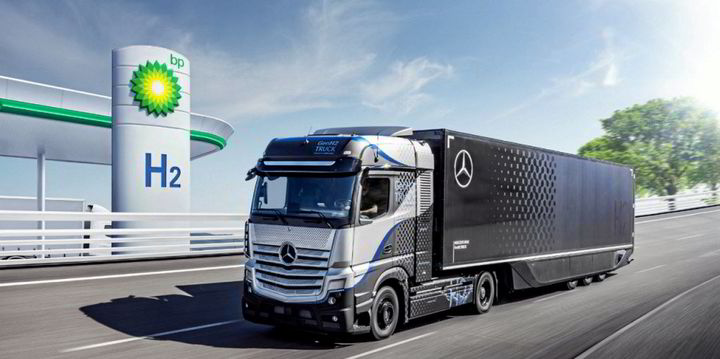
BP unveiled its largest green hydrogen initiative so far in its UK home market with plans for renewable H2 production in northeast England that it said could grow to half a gigawatt of electrolyser capacity by the end of the decade.
The oil and gas supermajor aims by 2025 to build an initial 60MW green hydrogen plant as the first step in its HyGreen Teesside project.
That could then grow in stages that “match production to demand” to 500MW of electrolysis by the end of the decade, adding to 1GW of planned blue hydrogen capacity – based on gas linked to carbon capture – under the already-announced H2Teesside initiative.
Matt Williamson, a vice president for hydrogen at BP, said the early focus of the planned electrolysis would be supplying a new generation of heavy trucks using fuel cells. The supermajor in late October signed a memorandum of understanding with Daimler Truck to jointly develop a network of UK refuelling stations, with a joint statement that explicitly referred to green hydrogen from renewable-powered electrolysis.
“HyGreen is the supply end of that,” Williamson told Recharge, adding that the first 60MW would be able to fuel about 1,300 large trucks of the sort that currently rely on diesel.
HyGreen and H2Teesside – which BP said between them could account for 30% of the UK government's 5GW 2030 target for H2 production – are themselves part of a wider push to turn the region into the UK’s first integrated hydrogen hub and a major source of the fuel for heavy industry.
Article continues below the advert
Asked if the addition of large-scale electrolysis alongside Teesside’s blue capacity suggests BP sees a significant customer base that will only want to buy the green variety, Williamson claimed that once the UK’s forthcoming low-carbon hydrogen standard is in place, the colour of the supply would likely be secondary “for the vast majority of customers”. But he added: “There will always specific customers that for whatever reason want to purchase a particular type of hydrogen.”
Making a start
Williamson also confirmed that the green hydrogen produced at HyGreen would start off pricier than the blue type. “It will definitely be more expensive to start with. But we have to start somewhere, the nation has to start somewhere, starting to establish that H2 network both in production and use. “Sixty megawatts is to a company the size of BP a small enough chunk to start with but big enough to make a difference,” added Williamson. “We know electrolyser costs and renewables power costs will come down.”
The scale of the first phase outstrips a 20MW electrolyser planned by Iberdrola in Scotland, which earlier this year was claimed as the largest so far planned in the UK.
BP is pursing one of the most ambitious renewable power build plans of any oil & gas group, with a target to have 50GW net on its books globally by 2030 and a pipeline that already includes a half-stake in 3GW of offshore wind in the Irish Sea that’s due in service later in the decade, with the potential for more major projects off the UK that could see part of their production allocated to renewable hydrogen. It is also in line to produce green H2 on a smaller scale in Aberdeen.
The company expects to make a final investment decision on the first phase of HyGreen by 2023, but like others advancing hydrogen projects in the UK it is waiting with bated breath to see what support will be available from the nation's government.
Complexities around generation
At least for the initial 60MW, Williamson said HyGreen Teesside would need to rely on renewable power purchase agreements (PPAs) to cover the electricity used by the electrolysers. The BP executive said he is “hopeful” that will be possible under a UK government review of its renewable transport fuel obligation (RTFO).
The RTFO – which sets out the rules governing green fuels for transport – is one element of a wider consultation by the UK government over its low carbon hydrogen standard that will set the complex parameters for hydrogen under the nation’s ‘twin track’ strategy which, to the consternation of some in the industry, recognises a role for both green and blue H2 and is due to include support to underpin investments in production.
Although the role of green hydrogen is far less contentious than blue’s – with UK support for the latter claimed by environmental groups as a licence for locking fossil fuels into the energy system for longer than necessary – there are still controversies around how to handle renewable H2 that is not directly linked to a dedicated co-located generation source.
These include whether and on what basis electrolysers should be able to draw on grid power that may itself not be fully decarbonised, how supplies can prove their green credentials, and the need for rules to ensure that the power for any green hydrogen gaining government support is additional to that used for the wider grid.
Williamson said BP would "work within government structures" as they evolve.
"heavy" - Google News
November 29, 2021 at 07:39AM
https://ift.tt/3D2imXB
BP eyes huge green hydrogen plant at UK's Teesside to fuel heavy trucks | Recharge - Recharge
"heavy" - Google News
https://ift.tt/35FbxvS
https://ift.tt/3c3RoCk
heavy
Bagikan Berita Ini














0 Response to "BP eyes huge green hydrogen plant at UK's Teesside to fuel heavy trucks | Recharge - Recharge"
Post a Comment